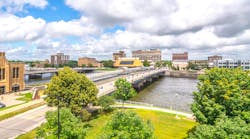Our nation has some of the world's most beautiful beaches and waterways. Unfortunately, trash such as cigarette butts, food packaging, cans and bottles and plastic waste discarded on land frequently makes its way into streams, creeks, rivers and eventually the ocean, as rainstorms wash it into gutters and storm drains. This trash detracts from the aesthetics of waterways and poses a threat to marine life and public health. It can also clog conveyance systems and outlet control structures leading to upstream flooding.
While many agencies have enacted specific trash control strategies, the State of California leads the nation in the development of trash control measures. In 2015, the California State Water Resources Control Board (State Water Board) adopted statewide Trash Provisions to address the impacts of trash on the state’s surface waters. The provisions established a statewide water quality objective for the prohibition of trash discharge to surface waters of the state. The Trash Amendments apply to all Phase I and II permittees under the NPDES municipal separate storm sewer systems (MS4) permits and Transportation MS4s. At the heart of these efforts are requirements to reduce environmental issues associated with trash in waters by installing, monitoring and maintaining stormwater BMPs that collect and retain trash and total suspended solids (TSS) from drains serving high-priority trash areas.
Adopted April 7, 2015, with an effective date of December 2, 2015, all phase one and two MS4 permittees with regulatory authority over priority land uses are required to comply with the prohibition of discharge by installing, operating and maintaining full trash capture systems. Priority land uses include high-density residential dwellings (greater than ten units per acre), industrial, commercial, mixed urban, public transportation and bus stops. The final compliance date was set for 10 years after the effective date, which is December 2, 2030.
Full trash capture systems are defined as systems (either a single device or a series of devices that trap 100% of particles that are 5 millimeters or greater and are sized to treat not less than the peak flowrate resulting from a 1-year, 1-hour storm event (design storm) or appropriately sized and designed to carry at least the same flows as the corresponding storm drain. The definition of trash does not include organic material such as vegetation, yard clippings, food wastes, pet wastes, sediments, sand, oil or grease, or things that are too large to fit in storm drains. The State Water Board maintains a list of certified Trash Full Capture Systems that can be used to meet the requirements.
Since the compliance deadline is only seven years away, many California municipalities are hurrying to plan and install full trash capture measures to meet the deadline. Richmond, California, located in the San Francisco Bay Area's East Bay region, is an excellent example of how one community addressed the new requirement.
Running through Richmond is Interstate 580, an east-west auxiliary Interstate Highway in Northern California with its own MS4 permit managed by the California Department of Transportation (Caltrans).
Since Caltrans and Richmond both needed to comply with the new regulations, it made sense to combine efforts, and CalTrans has a funding mechanism in place to do just that. Caltrans created a mechanism that enables them to provide funding for capital construction costs of stormwater treatment projects in exchange for transferring the responsibility of the maintenance and operation over to the local MS4. It is a win-win for Caltrans and the city. Caltrans provides funding for the treatment system, Caltrans and the city get a portion of their runoff treated to meet the new regulation, and the city pays for the long-term operation and maintenance of the system.
Engineering full trash capture systems can be challenging, as they often treat large drainage areas, accommodate large flows, are adjacent to receiving waters and must include uninhibited access for maintenance. The drainage was 129 acres, with roughly 100 acres covered on the city's permit and the remainder covered by the Interstate 580 permit.
The first challenge was finding a suitable location for the treatment system. Engineers considered several locations, but utility conflicts, high groundwater, access for maintenance, footprint requirements, property ownership, soil conditions and traffic control posed an issue. The final selection was on Cutting Boulevard. The primary challenge at this location was high flows, shallow depth, tidal influence and a nearby sewer line.
A 12-foot diameter CDS hydrodynamic separator was selected for this site. The CDS is a California Statewide Trash Amendments Full Capture System Certified device that uses continuous deflective separation – a combination of swirl concentration and indirect screening to screen, separate and trap debris, sediment and hydrocarbons from stormwater runoff. A Contech stormwater design engineer designed the CDS to handle a peak flow rate of 96 cfs and a treatment flow rate of 44 cfs.
The engineer also designed a custom 12-foot x 30-foot weir to allow the system to handle the treatment flow rate before going into bypass. The system was installed about 100 yards from the Bay. The long weir takes into concertation the mean high tide elevation and prevents overtopping, even when treating the peak flows. The top slab of the weir was custom designed to be thinner and allowed asphalt to be added without causing a bump in the road.
After all the work to find a suitable location and design the system, the team had approximately 10 weeks to complete the project or the Caltrans funding would expire. Most of the manhole and weir components were pre-cast. Careful coordination was needed to ensure all system components were manufactured and delivered on time. A Contech field consultant was on site to assist the contractor and ensure a proper installation.
In October 2021, the region experienced an "atmospheric river," bringing much-needed rain to the region. The storm intensity was more than a 100-year storm which put the system and the overall design to the test. The system performed as expected with no flooding during the unprecedented storm event.






